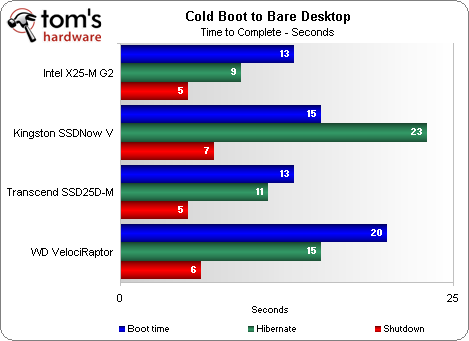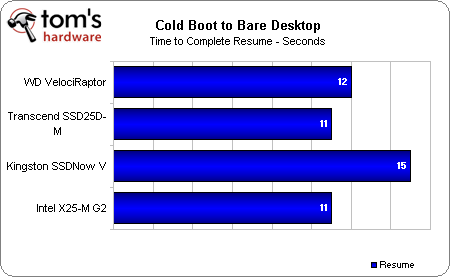Can Bargain SSDs Give Windows A Quantum Performance Leap?
Really Simple
Like majoring in Philosophy, synthetic benchmarks will only get you so far in life. Eventually, you need to join the real world and make some real observations about how things work. As much as I like PCMark’s app loading test, I figured it couldn’t get more real than apps and data off my own main system.
Still, it’s important to have a baseline. With little more than a handful of drivers loading in the background, I created a Windows 7 image with only one startup item, a .txt file containing the single word “Done.” All I wanted to start with was a load time spanning from the end of the POST process to that text document flashing onto the screen.
In these tests, lower times are obviously better. Even coming in fourth place, a 20-second boot for the VelociRaptor is still spectacular for a hard drive. Kingston manages the slowest hibernation time of the group, but how much this matters will depend on your usage. Personally, I never manually hibernate, instead telling Windows to do it automatically after 30 minutes of inactivity (I have Sleep mode kick in after five minutes). Transcend’s showing here is particularly impressive, tying Intel on both boot time and shutdown and trailing by only two seconds on hibernating.
Overall, I’m not sure this test tells us anything conclusive. Looking at it, you’d probably think the VelociRaptor was good enough, especially after figuring the price and capacity variables. Now let’s pile on the work.
Get Tom's Hardware's best news and in-depth reviews, straight to your inbox.
Current page: Really Simple
Prev Page Benchmark Results: PCMark Vantage, Continued Next Page Really Loaded-
timbo Dual drive ftw. It especially gives me an important advantage in loading mp maps faster: every second counts in getting to advantageous spots first; it can & does change the outcome of who wins.Reply -
I love how they neglect to include Linux, Unix and Mac. I guess that makes us just less important. By the way I'm pretty sure a SSD would make Ubuntu pretty snappy as well.Reply
-
zebow2002 Linux, Unix and Mac have a combined market share of 30%, wich makes them less important. Great article, can't wait for my Intel G2.Reply -
johnbilicki Two 64GB SSD's in RAID0 is more then enough for most users when a second RAID or bare drive is presumed. The main issue is still the cost per GB at $2-2.5 a GB I'm not knocking any one over even if it halves my boot and application time.Reply
Also in general please stop making socket 1156 like it's the best thing in town because Intel has made it clear that it's a mainstream socket and they will not be getting more then four cores ever; I am only saying this since as an upgrader I hate to see other people presume socket 1156 has a good upgrade path which it doesn't unless Intel changes it's mind and the last time I checked the upgrader's best friend is AMD (good motherboards/chipsets for under $400, unlocked multipliers for under a grand, unlocked cores, etc). -
xrodney I am using now 128GB patriot torx SSD as boot drive (only OS and few apps there leaving half drive not used) and rest apps and media having on 1.5TB 7200rpm drive.Reply
I was really thinking for 3-4 months before jumping on SSD but glad I did. Just 13 min to fully install W7, 15-18 seconds to desktop, 5-8 seconds to shutdown (5 no app running, 8 with loads of them started) and apps starting 3-8 times faster then with regular hdd.
Same as author 1st time booting to OS on SSD almost fell of chair as I was expecting to be it faster but not that much (3.5min boot time before) -
haplo602 wow ... I ma living on an ancient 40GB PATA drive at home. windows and linux and data. I really do not get how your boot drive can be 200GB of application only.Reply
a nice 64GB SSD drive would be just fine for all my needs.
one remark, can you include fakeraid (mobo implemented raid) raid1 configuration tests ? -
xrodney haplo602wow ... I ma living on an ancient 40GB PATA drive at home. windows and linux and data. I really do not get how your boot drive can be 200GB of application only.a nice 64GB SSD drive would be just fine for all my needs.one remark, can you include fakeraid (mobo implemented raid) raid1 configuration tests ?Its not that hard windows 7 64bit alone take like 15GB add hybernation file few apps and you are way over 40GB, some apps or games can have even more then 10GB (AoC have 30GB+).Reply -
Otus Looks like I might need to get a small SSD soon. Since my Ubuntu root (OS+apps) partition has just 4GB of data, I should be more than OK with a 64GB drive. Unfortunately stuffing Windows in there would be almost impossible.Reply -
xrodney SnarkI get the boot drive on desktop angle... but what about laptop installations?On laptop you should even see more performance boost as 2.5" drives they use are usually considerably slower then on desktop. Also you would get rid of possibility damaging disk when dropping your notebook as SSDs have no moving parts.Reply

